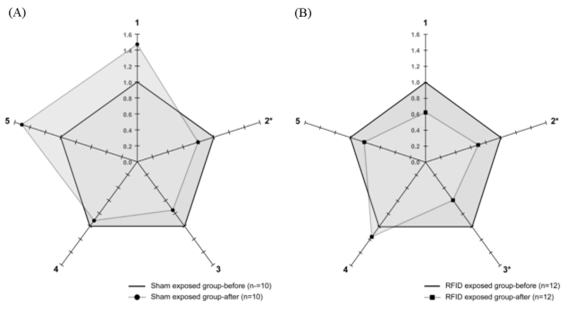글로벌 연구동향
방사선생물학
- [Int J Radiat Biol] Influences of exposure to 915-MHz radiofrequency identification signals on serotonin metabolites in rats: a pilot study 랫트 세로토닌 대사체에 대한 915-MHz 라디오 주파수 노출 영향: 파일롯 연구
아주대 / 김혜선, 안영환*
- 출처
- Int J Radiat Biol
- 등재일
- 2021
- 저널이슈번호
- 97(2):282-287. doi: 10.1080/09553002.2021.1844336. Epub 2020 Nov 16.
- 내용
-
Abstract
Purpose: The influences of radiofrequency electromagnetic exposure on animal health, particularly on serotonin metabolism, are not well-elucidated. In this in vivo study, we studied the influences of exposure to radiofrequency identification (RFID) signals on serotonin metabolism.Materials and methods: Twenty-two male Sprague-Dawley rats were assigned to sham (n = 10) and RFID-exposed (n = 12) groups. Rats in the RFID-exposed group were exposed to RFID signals at an average whole-body specific absorption rate of 2 W/kg for 8 h/day, 5 days/week for 2 weeks. Before and after RFID exposure, 24-h urine was collected from each rat. Urinary tryptophan, 5-hydroxytryptophan, serotonin, 5-hydroxyindoleacetic acid, and 5-methoxyindole-3-acetic acid concentrations were examined using gas chromatography-mass spectrometry, and changes in the patterns of values were compared between the two groups.
Results: Urinary levels of serotonin decreased by 20% (p = .041, Student's t-test) and 40% (p = .024, Student's t-test) in both the sham and RFID-exposed groups, respectively. The level of 5-methoxyindole-3-acetic acid decreased by 30% in the RFID-exposed group (p = .039, Student's t-test).
Conclusion: Our results indicate that exposure to RFID signals at a specific absorption rate of 2 W/kg is sufficient to alter serotonin metabolism in rats regardless of whether the exposure level is considered biohazardous.

RF 전자파를 일주일에 5일 2주간 노출시키고 (whole body SAR 2W/kg), 소변 내 세로토닌 대사체의 변화 여부를 관찰하였다. 두 군에서, 실험 후 5-MIAA가 감소하였으나, 세로토닌 수치는 RF 노출군에서만 의미 있게 감소한 소견을 확인하였다 (*p < 0.05, Student’s t-test). 무선 주파수 대역 전자파 노출에 의한 세로토닌 대사 영향 가능성을 제시하였다
Affiliations
Hye Sun Kim 1 2 , Man-Jeong Paik 3 , Chan Seo 3 , Hyung Do Choi 4 , Jeong-Ki Pack 5 , Nam Kim 6 , Young Hwan Ahn 1 2
1 Department of Neurosurgery, Ajou University School of Medicine, Suwon, Republic of Korea.
2 Neuroscience Graduate Program, Department of Biomedical Sciences, Graduate School of Ajou University, Suwon, Republic of Korea.
3 College of Pharmacy, Sunchon National University, Suncheon, Republic of Korea.
4 Radio Technology Research Department, Electronics and Telecommunications Research Institute, Daejeon, Republic of Korea.
5 Department of Radio Sciences and Engineering, College of Engineering, Chungnam National University, Daejeon, Republic of Korea.
6 School of Electrical and Computer Engineering, Chungbuk National University, Cheongju, Republic of Korea.
- 키워드
- Electromagnetic fields; rats; serotonin.
- 연구소개
- RF (Radiofrequency, 무선 주파수) 전자파의 세로토닌 대사에 미치는 영향을 연구하기 위해, 흰쥐에서 RF 전자파 (radiofrequency identification signal)를 조사할 수 있는 노출 장치를 이용한 동물 실험을 수행하였다. 총 22마리의 흰쥐를 두 군으로 나누고, 하루 8시간씩 1 주일간 노출하고 (whole body SAR 2W/kg), 소변을 채취하여 다양한 세로토닌 대사체의 변화를 GC-MS 장비를 이용하여 분석하였다. 두 군에서 모두, 세로토닌 대사체의 일종인 5-MIAA는 감소하였으나, 세로토닌 수치는 RF 노출군에서만 의미 있게 감소한 소견이 확인되었다. 이 결과를 통해 무선 주파수 대역 전자파 노출에 의한 세로토닌 대사 영향 가능성을 제시하였다.
- 덧글달기
- 이전글 [Clin Cancer Res.] Ipilimumab and Radiation in Patients with High-risk Resected or Regionally Advanced Melanoma
- 다음글 [Int J Radiat Oncol Biol Phys.] Diffusion Tensor Imaging-Based Analysis of Baseline Neurocognitive Function and Posttreatment White Matter Changes in Pediatric Patients With Craniopharyngioma Treated With Surgery and Proton Therapy









